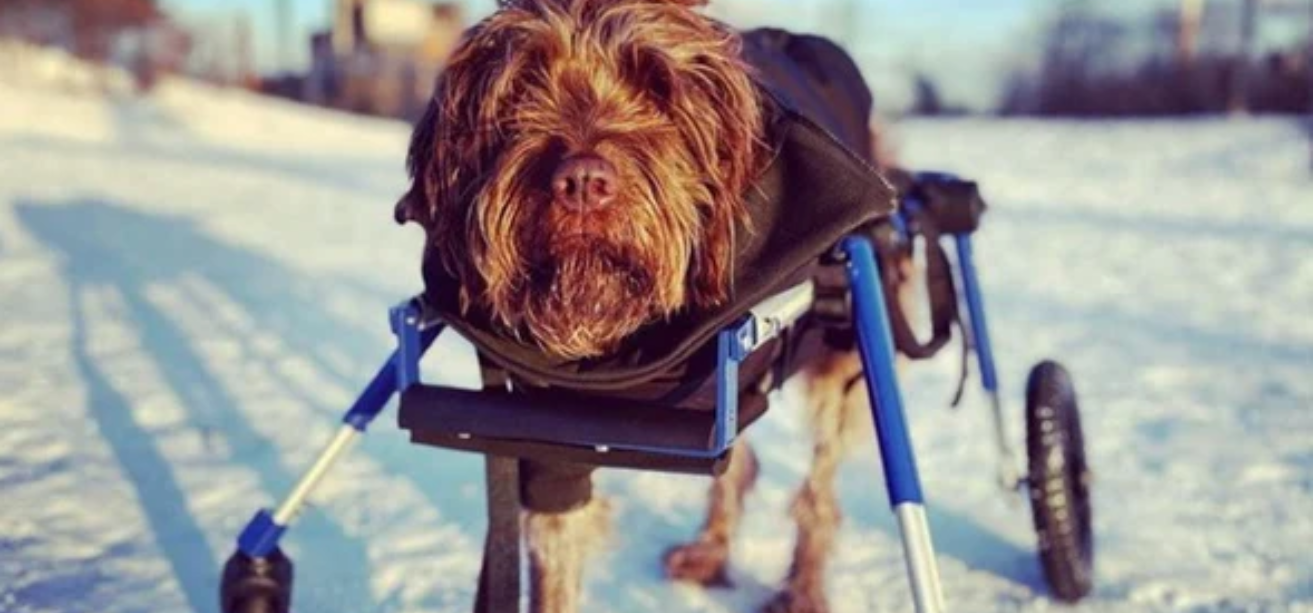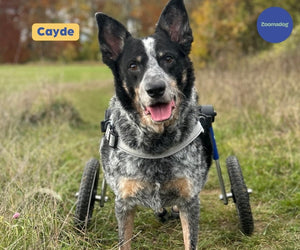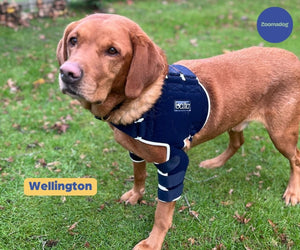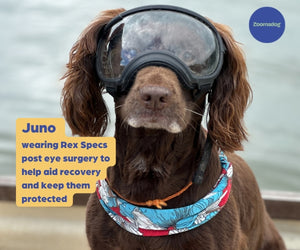01730 622544

Dogs with Front Leg Amputees or Front Leg Deformities
There can be a number of reasons why your dog either needs or has had a forelimb amputation, it could be from major trauma or infection, chronic pain or cancer. It can seem like a very drastic and devastating thing to happen to your dog however, amputation of a limb often means your dog can go on to enjoy a much better quality of life, without pain. Dogs adapt to amputation amazingly well. Although there is an adjustment period, many go on to live a happy and active life, without the constant pain they experienced pre-amputation.

Why your Dog may need an Amputation?
- Bone or soft tissue leg cancer such as osteosarcoma
- Severe trauma to the leg
- Non-healing fractures
- Severe infection in the leg
- Paralysis/non-functional front limb
- Severe limb deformity
Adapting to Front Limb Amputation in Dogs
Due to the physiology of a dog’s forelimb, amputation is always done at the shoulder joint (called a scapulothoracic disarticulation). The occasional exception to this, is where a prosthetic is used, however this is very uncommon. Leaving a partial limb or ‘stump’ is impractical as skin breakdown and further trauma, are almost inevitable.
Your Dog Adapting
One thing to keep in mind when thinking about your dog adapting to a life on three legs is that, if possible, try not to have too many changes all at once. Post amputation surgery, your dog is having to make many adjustments and have a lot of changes to process. So, if you can, try to make some of these changes pre-surgery. For example; using a sling, ramps, gates, getting used to toileting while on a lead or sleeping within an enclosed area.
Generally, dog’s function extremely well after a front leg has been amputated. In some cases, this is because due to pain or injury, they have in fact been non-weightbearing on their effected leg, limping or hopping, as a way of coping with their injury. This means that your dog has already started to adapt to getting around on three legs.
Weight and Weight Distribution/ Other Factors
Unfortunately for some dog’s, specifically obese and/or giant breed dogs or those with restrictions to the functioning of their other limbs, can have much greater difficulty adapting to only having three limbs. For large breed dogs or dogs with broad shoulders, (for example Staffordshire Bull Terriers) who carry most of their weight on their front legs, having a forelimb amputation can be much harder to adjust to, as opposed to the loss of a hind leg. It can also be especially difficult for older, arthritic dogs to fully adapt. In these cases, more care and provision need to take place when considering the option of a forelimb amputation and what kind of care they are going to require.
When thinking about how you can better help your dog adapt after a front leg amputation, there are a number of things which you can do. Firstly, keeping your dog a healthy weight is really important. The more weight your dog is having to carry, the more strain it then puts on their remaining limbs, other muscles groups and skeleton. It varies dog breed to dog breed, but on average a dog can distribute up to 65% of their body weight onto their front limbs. This means that if one of their front limbs is amputated, your dog will then shift the extra 30% onto their sound limb. Again, depending on the breed, a small percentage may also be transferred into their hind limbs. Common problems with dogs who have had front-limb amputations include; wrist and shoulder issues, premature arthritic changes to the spine and rear legs, stiff and sore muscles, all of which are due to overcompensation.
Phantom Limb Pain
Occasionally a side effect of limb amputation in dogs, is phantom limb pain, this is a phenomena which humans who have had a limb amputated, experience too. Phantom limb pain is when your dog licks or scratches around the area where the amputated limb used to be. There can also be some muscle twitching or other behaviour changes. As with lots of post-surgery recovery, time is the best way to heal this issue. However, if you’re concerned or if your dog is experiencing phantom leg pain long after their surgery, you should speak to your vet.

Prognosis
Depending on why your dog has had to have a forelimb amputation, prognosis can vary. In the case of injury or trauma, in the majority of cases, your dog will adapt amazingly well and go on to lead a full, happy and normal life. Sadly, in the case of amputations occurring due to cancer, prognosis is less good and depends on which cancer is present. Although it is possible for amputation to be curative in some low-grade soft tissue sarcoma’s, generally, amputation is seen as a palliative measure, extending life by a few months or a year and eliminating a source of pain for the dog.
How to Help your Dog Around the House
As your dog adapts to life on three legs, there are some things which you can do around the house to help them. Some of these measures are only temporary but others will continue to be helpful. As mentioned above, if it’s possible to make some of these changes before your dog has their limb amputated, all the better, as it makes all the changes post-surgery less overwhelming.
Bed and Breakfast
Immediately after surgery your dog can benefit greatly from recovering in a comfortable space with plenty of soft, thick bedding and/or a nice, cushy dog bed. Keep everything in close range, so as to be easily accessible, without your dog having to reach too far down or strain too far up or even, especially in the beginning, having to stand up at all – think breakfast in bed!
More long-term, consider investing in raised food and water bowels, as this makes it easier for your dog to balance while eating and drinking without having to bend forward, which is especially difficult for front-limb amputees. Custom elevated bowels can be bought however you can also do a DIY job, by placing their normal bowls on top of a box or some other similar object. Try to make them level with your dog’s chest.
Slings
After surgery, and while your dog is learning to redistribute their weight onto their remaining three legs, they can often wobble when trying to get up from lying. Using a sling under your dog’s chest, can help provide additional support when your dog is getting up from their bed or squatting when going to the toilet. These can be specialised slings or a DIY version, using a towel or piece of soft fabric. Ensure you stand on the side of the amputation, so you can be the counterweight when you help your dog walk and balance.
Slippery Surfaces
Another issue can be slippery floors. It’s important to try to avoid slippery floors and other hazards. If an amputee dog falls or slips they could damage the area around their surgical site and lose confidence in moving about. Wood or tile floors can be especially difficult for your dog to keep their balance on, to not fall over and walk confidently. You can either put down carpets or mats, (making sure they do not slide across your floors either!) with non-slip undersides. Or alternatively get your dog some socks or boots with griped undersides. These can be helpful both inside and outside and helps prevent your dog from slipping and falling, while learning to navigate on only three legs.
Gates
Putting baby gates in place to keep you dog in a controlled area or away from danger areas where they need close supervision, such as stairs, can be a very good idea.
Equipment and Additional Treatment for Front Limb Amputation in Dogs
When your dog has an amputation, there will be extensive aftercare instructions from your vet, as well as a rehab programme. It is important that you follow these instructions carefully as they will apply specifically to your dog, whereas other resources, although helpful, will be general.
Aftercare can involve the immediate care needs of your dog, as well as the longer-term treatment and rehab, such as:
- Front Amputee Harness
- Slings, Ramps and Other Equipment
- Physio Therapy and Laser Therapy
- Water/Hydro Therapy
- Prosthetics
- Front Wheelchairs and Quad Wheelchairs
Equipment
As touched on above, there is a range of equipment available which you can use to make it easier for your dog to navigate on three legs. If you have stairs inside or outside that your dog must use, consider how to makes these easiest for your dog. A sling or harness can be helpful. A ramp can also be great, weather its over steps or even used to help your dog into or out of your car. If you will need a ramp, consider planning for it beforehand and get your dog used to it if you have time. You can slide a sling, towel or even an opened canvas bag under your dog’s belly or chest to help your dog with walking and stairs also. Similarly, a harness can be used in some instances. Remember to stand on the side of the amputation, so that you are in counterbalance.
Rehabilitation and Therapies
When your dog has an amputation, the actual surgery is just the beginning. Your vet will give you comprehensive aftercare instructions and a rehabilitation package, which should involve some element of physical therapy, hydro therapy or similar. It is so important that your dog does not do too much too soon, for some dogs this is difficult! They need to build up strength in compensatory muscles and remaining limbs. Alternative forms of exercise such as hydro-therapy, underwater treadmill work and swimming can be a great way to expend energy and build strength.
Your dog will come home with comprehensive pain killers also. These can be adjusted as needed in relation to how your dog is coping however, often laser therapy is used for a time post-op, to further help with pain control.
Because your dog is having to compensate for the loss of a limb, their weight is transferred onto other muscles groups and the skeleton. Over time, this abnormal strain leads to arthritic changes of the remaining limbs and spine as well as other mobility issues. To help your dog in the long-term, it is important to keep them slim and healthy to avoid excess strain on the remaining legs and avoid high-impact exercise. To maintain muscle strength and encourage effective use of the other legs, ongoing physiotherapy and hydrotherapy can be extremely beneficial.
Prothesis
In some rare cases a partial amputation can be done, with enough of the affected limb being able to be left to then attach a prothesis. However, this is not at all common due to it being a complex choice with a high risk of further complications.
Prosthetics can be helpful in reducing the strain and compensatory injuries that can occur from the change in weight distribution. For older dogs who have osteoarthritis/arthritis in other joints, a prosthesis may provide additional stability. However, the stump and prosthetic require daily and very close care and monitoring with a very high risk of ongoing breakdown and infection. Also, dogs may require multiple prosthetics and this becomes very expensive.
Front Wheelchairs
Dogs can adapt amazingly well to the loss of one front limb however compensating for the loss of a forelimb eventually takes its toll on the remaining limbs and the spine, with hopping often causing premature arthritic changes and other stress injuries to bone and muscle, which is having to compensate. With dog’s carrying up to 65% of their body weight on their front limbs, giving your dog Wheels will support this weight, without compromising other muscles in their body. There are a few options when it comes to wheelchairs for front amputees.
Walkin Wheels make a quad wheelchair which can really help to support your dog and keep them mobile. This wheelchair, as the name suggests, consists of four wheels (one in each corner) with a frame. The Quad wheelchair offers support underneath your dog’s belly, so that they don’t have to support all of their weight themselves. This means that your dog can still run around and exercise and thereby use their muscles without getting so tired. There is the additional option of an Amputee Cover which helps to remove pressure points and improves comfort while your dog is using the Quad. The Quad is also versatile, and can be used on pavements, footpaths or grass.
A more specialised wheelchair for front amputees is made by Eddie’s Wheels. If your dog has a disability which affects one or both front legs, then Eddie’s Wheels can be a really excellent choice. It’s simple, two wheeled design, has been specifically tailored for dogs with injured forelimbs or amputees affecting forelimb mobility. They are designed to allow your dog to use its functional legs, while taking the weight-bearing load off the front limbs.
Eddie’s Wheels Front Wheelchair are unique and the only front wheelchair designed to allow your dog to sit and squat, as well as bend to sniff the ground. Because it is made with two wheels which are independent of your dog’s hindquarters, it means they can carry on just as if they had use of their front legs again. These are custom made and unique to your dog.

Wheelchairs can really transform your dog’s life in a number of ways. For older or arthritic dogs, where amputation may not be a practical option and who would struggle to adapt and support themselves without both forelimbs. For giant breeds and dogs who carry large weight-bearing loads on their front limbs. And also for young and active dogs, it can give them back their bounce without the associated repercussions from compensation to muscle and bones.
Support Groups
Weather your dog has already had an amputation or if you are just starting out on your amputation journey, it can be incredibly helpful to join and follow dog amputee support groups. These are full of personal knowledge, tips, hints and helpful pointers. It can also be a very helpful place for you to ask questions of other dog owners who may have a similar situation to you and your dog.
Limb amputation doesn’t have to be the end of the world. Seeing a content and happy dog on three legs can demonstrate how instead, amputation can be the beginning of a new chapter in your dog’s life, a positive option that can extend their life and remove the pain they had before. Your vet will only advocate amputation surgery if it is beneficial, so you should know that if this happens to your dog, you are doing the kindest thing you can.

Looking for help with your dog?
We can help find the right solution for your dog
Feel free to give us a call on 01730 622544
or email us at woof@zoomadog.co.uk







Leave a comment